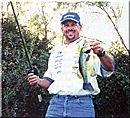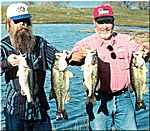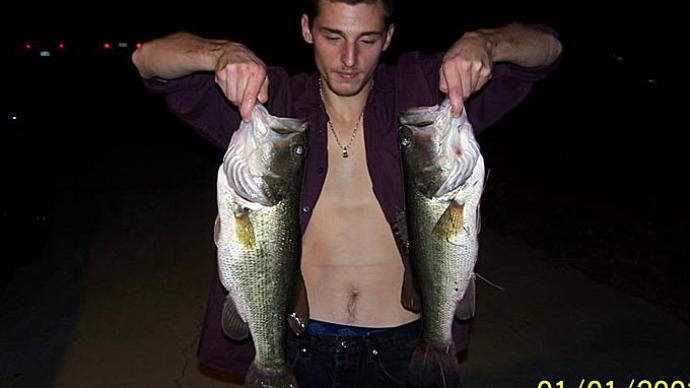
Here we are again, facing the tremendous heat of summer. In the desert southwest, during the so-called "dog days" of summer, anglers feel the heat and so do the fish. Summertime temperatures can reach well over 100 degrees with water temperatures reaching above the 80-degree mark. When the water gets this hot, bass are no different from the rest of us; they seek out any opportunity to escape the boiling water. Whether it's under a weed mat, hidden in oxygen-giving timber, the shade of a boat dock or positioning themselves near a cool running inlet, be assured, the bass are still feeding actively. You may need a couple gallons of Gatorade and a wet towel, but the fishing action can be sizzling!
As with any change of season or temperature, anglers need to adjust their tactics. There are several methods for catching bass during the dog days of summer. For instance, what about deep-water sight fishing? Hold on a minute, you say ... how can we sight fish when bass are 20 feet deep? How about using your electronic eyes?
Mark Lassagne, a West Coast professional who guides on the California Delta and fishes the Sierra foothill reservoirs regularly, has fine-tuned this method. "By using my fish finder I can locate fish quickly that are 20 or more feet deep. I have found these fish to be relatively easy to catch. Sight fishing by using electronics during the hot summer days can be extremely effective," said Lassagne.
When the summer sun gets high and hot, bass will either hide under the shade of structure or weed mats, or they will head for deeper water. While other anglers are banging the banks, Lassagne glides his boat over the deeper water looking for underwater points and clay flats. Once these are located he then looks for fish on his electronics. He isn't looking for schools of shad or large groups of fish, he is looking for that single fish right on the bottom. "Bass located a few feet off the bottom don't usually hit my bait and groups of fish don't seem to be actively feeding," said Lassagne. "A single fish or sometimes two together are much more likely to fall for this technique."
When the fish are located, Lassagne will immediately drop a 3-inch paddle grub down. The grub is Texas-rigged with a 3/16-ounce weight. "I just keep hitting my trolling motor and then let it glide. I don't want to pass any fish up," said Lassagne. "When I spot a fish, I quickly drop my grub down to it. The key is to get the bait down quickly and fish vertically. If I notice my line starting to drop at an angle I back my boat up. Once I know the bait is right in front of the fish I shake it lightly, just to enough to take up the slack. It usually only takes about 10 to 15 seconds and if the fish doesn't take the lure, you might as well move on to the next one."
Mr. Lassagne has discovered fish in this scenario aren't as timid as the ones found close to he bank. At this depth they apparently have a lot more confidence and are more willing to strike. "To do this technique effectively requires high-end electronics with a high pixel count," said Lassagne. By using a high pixel count finder, he has also discovered that he can many times choose the better fish.
The other key to success with this technique is to get the lure down to the bottom quickly. To ensure a rapid decent, Lassagne likes to use a very thin-diameter line. He uses Sufix Tritanium line in a 10-pound test. "This line is very strong, has great abrasion resistance and is very thin in diameter - perfect for this technique," says Lassagne.
Generally speaking, Lassagne prefers using spinning tackle for deep- water sight fishing. "I use a 6-foot 6-inch Revolver worm and jig rod made by Competitive Edge. The rod is extremely sensitive which is crucial to this style of fishing," He noted. As for hooks, the Gamakatsu EWG seems to work best for Lassagne, "The extra wide gap hooks holds the bait straighter than straight shank hooks. I tend to get more and better hookups with the EWGS," said Lassagne.
As with most spinning tackle, sometimes you will suffer with line twist. If you find yourself battling with line twist, Lassagne has the answer. "When I fish this technique heavily, I will at times tie on a small swivel with a split ring. I cover the swivel by pushing the bait up on it. This helps to eliminate much of the line twist problems. But, I only do this if I'm deep-water sight fishing all day."

As we head into the desert southwest, we find summertime temperatures skyrocketing well over the century mark. Lakes such as Roosevelt, Canyon, Pleasant and others located in the scorching desert can become difficult, if not downright frustrating to bass anglers. Besides the blazing sun, weekend warriors pack these lakes during the summer to find their own methods of cooling off. Water skiers, jet skiers, pleasure boaters and swimmers cause many anglers to put their rods in the locker and concentrate on mowing their lawns. Well, according to bass professional Mark Kile, keep those rods in the boat, the fishing is GREAT!
"Even though the air temperatures can reach well over 100-degrees, the water temperature is usually a lot less than people think," said Kile. "In the desert, the temperature drops dramatically when the sun goes down. So, unless you're talking about a shallow flat or bay, the water's surface temperature will rarely reach the 80-degree mark. A few feet under the surface the water temperature gets very comfortable for bass.
Because of the extreme heat, it's best to go out in early morning or late evening," Kile stated. "Not so much because of the bass but because summertime boat traffic can be a nightmare, especially on the weekends. Besides, it's much more comfortable for the angler. Another great time for desert fishing is at night. The night fishing in the desert can be exhilarating. Here in Arizona, many of the tournaments are held at night in the summer because it's cooler and because the lack of boat traffic makes it safer for those who take it easy and know the lakes well.
"Although," said Kile, "boat traffic can be used to your advantage." The waves created by boats can create a simulated wind and can even muddy banks up, making the fish less skittish, but for the most part, the traffic makes it frustrating for the angler."
When Mark Kile is fishing at night he uses his go-to bait, a big bag of 4-inch Westy Worms in a black and yellow or red and purple. "When you ask a tackle shop in Phoenix what to use at night on Roosevelt Lake, they will almost always tell you to grab the Westy Worms," said Kile. "These worms are very effective on the bass; they are a simple design with two built-in hooks, but they really work! I break out the spinning gear and fish the main lake points and humps vertically. Not on the banks, the fish have pulled off of the banks. I find fish in 20 to 30 feet of water and have caught over a 100 fish in a night.
"John Murray showed me a trick about night fishing. He showed me that when the fish stop biting you could find them suspending. Just drop a Westy Worm through the suspending fish and hang on. It works great!
"It's best to use a 4-inch Westy Worm except right at sunset or sunrise, then you can use the 6-inch worms. When the wind kicks up I will use a heavier weight to get the worm down to the fish. I have caught 11-pound bass on the Westy Worm."
Kile uses his electronics to locate the "activity zone. "After I put the boat in the water I slowly idle out and watch my graph," said Kile. "While I'm idling out I can locate baitfish and other activity and know approximately where the zone will be once I'm out on the lake. This really helps to narrow things down quickly."
Night fishing can have its challenges: being able to see your line twitch with a subtle strike is nothing short of difficult at night. Kile utilizes black lights and fluorescent line to increase his strike detection. When he fishes reservoirs like Lake Pleasant, Kile has discovered that the lights located on the docks, or by the dam, can be very productive. "The lights draw baitfish and where the baitfish go, the bass must follow," said Kile. When fishing desert lakes in the baking sun, the techniques are similar to those Kile uses during the night. The biggest change he makes is in the color of his Westy Worm. "During the day I change colors and go to a red. I fish the deeper structures. I especially like fishing humps or points that drop off into deeper channels," Kile noted.
Later in the summer, around August, the desert monsoon season kicks into high gear. These storms can be spectacular and cause many anglers to head for the house, but, according to Mark Kile, this can be the most productive times for anglers. "The monsoons really turn the fish on and the morning topwater bite can be very exciting," Me said. "The massive influx of water acts like a giant aerator, bringing in high levels of oxygen and a lot of fresh nutrients. When the creeks and rivers start flowing well, they create a good mud line. Fishing along these waterways with a buzzbait can be exhilarating!"
The other piece of advice Kile offers is this: "Never be afraid to throw a top water bait, even if the fish are 20-feet down. Think about it this way; your bass boat is usually around 20-feet long and walking from one end to the other isn't very far. It's the same for the bass. A bass has no problems at all coming up 20 feet to snatch a buzzbait or chugger. So, always keep a topwater bait on hand and use it."

Don Payne, professional angler and guide in the central part of California has some unique techniques for summer angling. "When the summer sun gets to boiling we have to adapt to the fish and understand the differences and how the reservoirs work," said Payne. "On lakes like Clear Lake or if you're fishing the Delta, it works best for the anglers to get up real early and fish for a few hours and then go home and work in the garden. If nothing else, the boat traffic during the summer can really hurt your fishing. On the reservoirs it can be different.
"The reservoirs around here are used for hydroelectric power and irrigation, so in the summer they tend to draw a lot of water off the lakes quickly. This can work to the angler's advantage. As they draw water off they are creating a current in the lake. When this is happening I like to find the narrow parts of the lake which will concentrate the current. I pick out five or six points in these narrow areas and start making a 'milk run.' This is where the water is moving the best and you will soon come in contact with the fish when they turn on. And, when they turn on, they all turn on at once."
For this technique, Don Payne uses a small 4-inch PowerBait worm from Berkley on spinning gear. "I uses a split shot technique when the fish are less than 25 feet deep; if they are over 25 feet, I go to a baitcast reel and switch to a Carolina rig," Payne stated. "No matter how deep they are, I seldom will use anything heavier than a 1/2-ounce weight. Summer fish are finicky and will more readily accept small baits, but they will eat!"
Finding the thermocline in a reservoir used for electricity and irrigation can be difficult due to the constant stirring of the water. Payne has a technique he uses to determine the approximate location of the thermocline. He takes a brightly colored lure and drops it down the side of the boat until he loses sight of the lure, then he measures how much line he let out, adds three feet and this gives him the approximate depth of the thermocline. 'The water usually drops in temperature just below the first light break," Payne said.
While fishing Clear Lake, Payne has started using a method he calls "flipshotting," basically downshotting with a flipping stick and heavy line. "I was fishing on Clear Lake and the bass were really deep in the weeds," said Payne. "I was flipping the weeds but the fish were suspended off the bottom, so I tried downshotting them. It was no use, as soon as the fish hit, they would have the light tackle wrapped up in the weeds and come unbuttoned. So, I thought about it and then broke out my flipping stick again. I set up a downshotting rig on the heavy action rod and 25-pound test line. The hook was tied about three feet off the bottom and I had a 3/8-ounce weight on the bottom. The worm stayed just above the weed line and the bass were slamming it. The heavy action rod and line gave me the ability to get the fish out."
The "dog days of summer," can be a challenge for bass anglers. Staying cool, keeping clear of non-anglers, not burning the backs of your legs when you crawl back in the truck with shorts on, locating deodorant strong enough to keep you from smelling like a catfish and being able to get a boat on plane with a truck load of Gatorade in the ice chest is tough enough. Catching summertime bass is a challenge, but try these hot-weather tips and when you show your friends pictures of your catch, you'll be the coolest person around.
Reprinted with permission from Bass West Magazine




